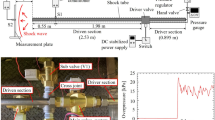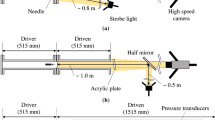Abstract
A Shock tube is a piece of equipment in which, by creating a pressure difference between the driver and the driven section via the bursting membrane, it has the ability to generate shock waves with very short rise time. One of the important parameters in the shock tube is the planar shock wave and the distance of its formation along the driven section. In this study, the shock wave pressure was measured at different sections along the shock tube as well as at different radial distances, using three piezoresistive pressure sensors. Experiments were repeated with three different thicknesses of diaphragms 0.1, 0.2, and 0.3 mm. Diaphragms were made of Mylar. The results of the tests were extracted using TRAww software, which is a software for signal processing of the pressure sensors, and the distance of the planar shock wave for different diaphragms was obtained. The results show that by increasing the diaphragm thickness and thus increasing the explosion pressure (pressure of the driver area), the shock wave pressure increased, and the planar shock wave propagates further away in the driven section. The uniform duration of the shock wave using a diaphragm with a thickness of 0.1 mm is smaller than the other two diaphragms, and the planar shock wave is not stable until the end of the shock tube. Also, the pressure drop in the driven section after the failure of the diaphragm increases with increasing diaphragm thickness.













Similar content being viewed by others
References
Gong L, Duan Q, Jiang L, Jin K, Sun J (2016) Experimental study of pressure dynamics, spontaneous ignition and flame propagation during hydrogen release from high-pressure storage tank through 15 mm diameter tube and exhaust chamber connected to atmosphere. Fuel. https://doi.org/10.1016/j.fuel.2016.05.127
Glass I (1951) An experimental determination of the speed of sound in gases from the head of the rarefaction wave. University of Toronto, Toronto
Resler EL, Lin SC, Kantrowitz A (1952) The production of high temperature gases in shock tubes. J Appl Phys. https://doi.org/10.1063/1.1702080
Emrich RJ, Curtis CW (1953) Attenuation in the shock tube. J Appl Phys 24:3. https://doi.org/10.1063/1.1721279
Lundquist GA (1952) Shock wave formation in a shock tube. J Appl Phys 23:3. https://doi.org/10.1063/1.1702215
Nguyen TTN, Wilgeroth JM, Proud WG (2014) Controlling blast wave generation in a shock tube for biological applications. J Phys Conf Ser. https://doi.org/10.1088/1742-6596/500/14/142025
Glass II, Theoretical “A (1995) Experimental study of shock-tube flows. J Aeronaut Sci 22(2):73–100. https://doi.org/10.2514/8.3282
Diao K, Yao Z, Wang Z, Liu X, Wang C, Shang Z (2019) Investigation of vibration effect on dynamic calibration of pressure sensors based on shock tube system. Measurement : 107015. https://doi.org/10.1016/j.measurement.2019.107015
Liang R, Wang Q-M (2015) High sensitivity piezoelectric sensors using flexible PZT thick-film for shock tube pressure testing. Sensors Actuators A Phys 235:317–327. https://doi.org/10.1016/j.sna.2015.09.027
Justusson B, Pankow M, Heinrich C, Rudolph M, Waas AM (2013) Use of a shock tube to determine the bi-axial yield of an aluminum alloy under high rates. Int J Impact Eng. https://doi.org/10.1016/j.ijimpeng.2013.01.012
Anderson JD (1982) Modern Compressible Flow with Historical Perspective. Tata McGraw-Hill Education, New York
Endevco (2015) Piezoresistive pressure transducer Model 8530B -1000
Author information
Authors and Affiliations
Corresponding author
Ethics declarations
Conflict of Interest
The authors declare that they have no known competing financial interests or personal relationships that could have appeared to influence the work reported in this paper.
Additional information
Publisher’s Note
Springer Nature remains neutral with regard to jurisdictional claims in published maps and institutional affiliations.
Rights and permissions
About this article
Cite this article
Sardarzadeh, F., Zamani, J. Experimental Study of a Disk Diaphragm Thickness Influence on a Planar Shock Wave Formation and Position During its Propagation in a Gas Shock Tube. Exp Tech 45, 497–508 (2021). https://doi.org/10.1007/s40799-020-00412-6
Received:
Accepted:
Published:
Issue Date:
DOI: https://doi.org/10.1007/s40799-020-00412-6




